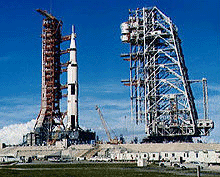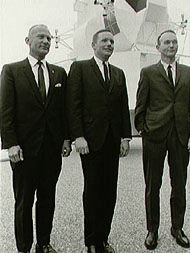
 |
| Apollo 11 before liftoff (NASA) |
 |
| Buzz Aldrin, Neil Armstrong, and Michael Collins in front of a model of the LM (NASA) |
First Space Flights
On Wednesday, July 16, 1969, Apollo 11 stands on the launchpad, ready for liftoff.A few weeks earlier, an American spy satellite had spotted a huge rocket awaiting launch in the Soviet Union. But a few days later, the satellite picked up a black pit of smoking ruins. The rocket had blown up. If Apollo 11 avoids a similar fate, America will win the race to the moon.
The astronauts are ready. Armstrong has mastered flying the Lunar Module (LM, pronounced lem) using a trainer. The LM is the part of the spacecraft that will separate from the "mother ship" — the Command Module piloted by Collins — and take Armstrong and Aldrin to the moon.
Mike Collins has perfected 18 different rendezvous for the Command Module. If the LM makes it off the surface, but not all the way to orbit, the Command Module will swoop down and grab it.
Aldrin has moonwalking down to a fine art. He and Armstrong will have less than three hours on the surface — not a minute to waste. All three men spend weeks practicing in simulators.
Before going into quarantine for 21 days, the astronauts spend a last weekend with their families. They all know they might not come home again.



